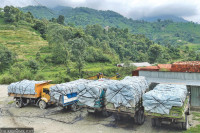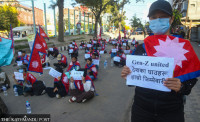Valley
City dwellers do not support government health programmes and services
Working as a female community health volunteer in city areas is more difficult in comparison to remote villages and hinterlands. Health volunteers say city people are not supportive of the government’s health programmes.
Arjun Poudel
Two weeks ago, a female community health volunteer deployed by the health department of Kathmandu Metropolitan City was doing her regular rounds, cataloguing patients and informing them about free treatment and surgery services available at Bir Hospital, when a man invited her into his home on the pretext of talking about his medical problem and flashed his genitals at her.
The woman was shocked by the incident and filed a complaint against the man at the department. Her friend Sabitri Mainali, also a community health worker, said “Since the incident, we have stopped going on our rounds alone.”
According to her, female community health volunteers are often mocked and shooed away by the city residents saying that they do not require government’s free health services.
Working as a female community health volunteer in city areas is more difficult in comparison to remote villages and hinterlands. Health volunteers say city people are not supportive of the government’s health programmes.
Sarmila Sapkota has been working as a female community health volunteer in Kathmandu Metropolis-14 for the last 24 years.
Over the years, she has had doors slammed on her face for numerous times and even physically thrown out of homes by their owners.
According to her, people do not seem to buy the idea of free health care offered by the government and see community health volunteers as nuisance.
“Some people believe that the medicines and services provided by the government lack quality and are distributed for trial purposes,” she said.
In a study carried out last year by the Kathmandu Metropolitan City, several children in the metropolis had not been administered mandatory vaccines.
To conduct the study, the health department had deployed female community health volunteers to every household to collect the data on immunisation.
“People from well-to-do background, who can afford private medical services, don’t even talk to us. When we inquire about the number of children in the household they flatly refuse to give us information,” said Sapkota.
Narendra Bajracharya, chief of health department of the Kathmandu Metropolitan City, said that most of the city residents are unsupportive of the government’s health programmes.
Health coverage in Kathmandu is low compared to other parts of the country. The total coverage of vitamin A supplement programme was only 77 percent last year, whereas the overall coverage throughout the country stood at over 85 percent.
The coverage rate of mass drug administration against lymphatic filariasis was only about four percent in some wards of the metropolis.
Another study carried out in the past by the Kathmandu Metropolitan City found that women in the cities, especially Kathmandu, do not receive antenatal check-up and their children are not fully vaccinated.
“The overall coverage rate of the government health programmes is low in Kathmandu. We are working towards solving this problem through awareness programmes to inform citizens about the health services offered by the government.”
Dr Baburam Marasini, former director at the Epidemiology and Disease control Division of Department of Health Services, said that the concerned agencies should take a approach to deal with the city population and the poor health coverage rate in city areas. “If one approach fails to yield results, we should look for the next viable approach,” said Marasini.




 23.12°C Kathmandu
23.12°C Kathmandu










